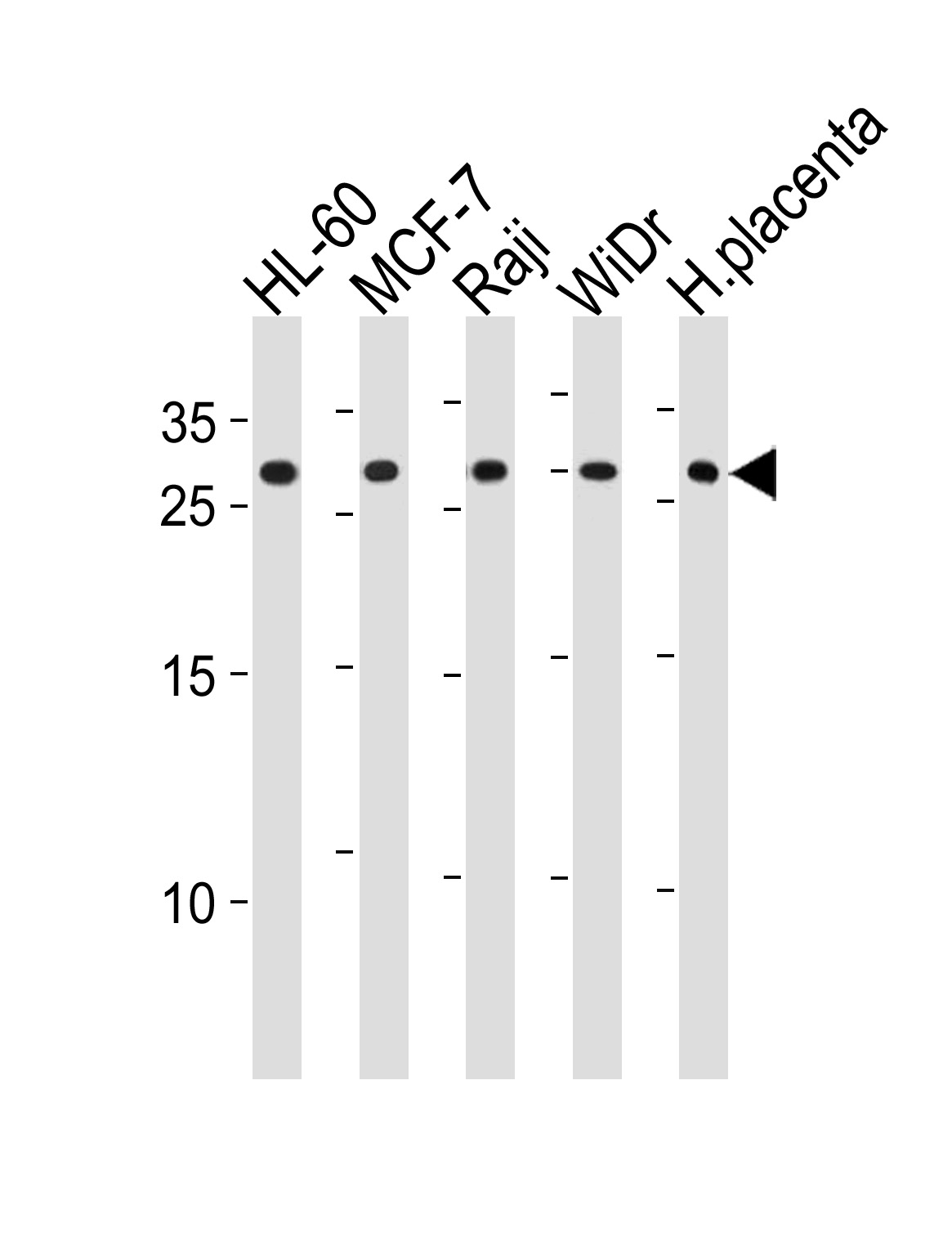CLIC1 Antibody (Center)
Affinity Purified Rabbit Polyclonal Antibody (Pab)
- 产品详情
- 实验流程
- 背景知识
Application
| WB, E |
|---|---|
| Primary Accession | O00299 |
| Reactivity | Human |
| Host | Rabbit |
| Clonality | Polyclonal |
| Isotype | Rabbit IgG |
| Calculated MW | 26923 Da |
| Antigen Region | 136-166 aa |
| Gene ID | 1192 |
|---|---|
| Other Names | Chloride intracellular channel protein 1, Chloride channel ABP, Nuclear chloride ion channel 27, NCC27, Regulatory nuclear chloride ion channel protein, hRNCC, CLIC1, G6, NCC27 |
| Target/Specificity | This CLIC1 antibody is generated from rabbits immunized with a KLH conjugated synthetic peptide between 136-166 amino acids from the Central region of human CLIC1. |
| Dilution | WB~~1:1000 E~~Use at an assay dependent concentration. |
| Format | Purified polyclonal antibody supplied in PBS with 0.09% (W/V) sodium azide. This antibody is purified through a protein A column, followed by peptide affinity purification. |
| Storage | Maintain refrigerated at 2-8°C for up to 2 weeks. For long term storage store at -20°C in small aliquots to prevent freeze-thaw cycles. |
| Precautions | CLIC1 Antibody (Center) is for research use only and not for use in diagnostic or therapeutic procedures. |
| Name | CLIC1 {ECO:0000303|PubMed:16339885, ECO:0000312|HGNC:HGNC:2062} |
|---|---|
| Function | In the soluble state, catalyzes glutaredoxin-like thiol disulfide exchange reactions with reduced glutathione as electron donor. Reduces selenite and dehydroascorbate and may act as an antioxidant during oxidative stress response (PubMed:25581026, PubMed:37759794). Can insert into membranes and form voltage-dependent multi-ion conductive channels. Membrane insertion seems to be redox- regulated and may occur only under oxidizing conditions. Involved in regulation of the cell cycle. |
| Cellular Location | Nucleus. Nucleus membrane; Single-pass membrane protein. Cytoplasm. Cell membrane; Single-pass membrane protein. Endoplasmic reticulum {ECO:0000250|UniProtKB:Q6MG61}. Note=Mostly in the nucleus including in the nuclear membrane (PubMed:12681486, PubMed:9139710). Small amount in the cytoplasm and the plasma membrane (PubMed:9139710). Exists both as soluble cytoplasmic protein and as membrane protein with probably a single transmembrane domain (PubMed:11551966, PubMed:11940526, PubMed:12681486, PubMed:14613939, PubMed:9139710). Might not be present in the nucleus of cardiac cells (By similarity) {ECO:0000250|UniProtKB:Q6MG61, ECO:0000269|PubMed:11551966, ECO:0000269|PubMed:11940526, ECO:0000269|PubMed:12681486, ECO:0000269|PubMed:14613939, ECO:0000269|PubMed:9139710} |
| Tissue Location | Expression is prominent in heart, placenta, liver, kidney and pancreas. |
For Research Use Only. Not For Use In Diagnostic Procedures.
Provided below are standard protocols that you may find useful for product applications.
BACKGROUND
Can insert into membranes and form chloride ion channels. Channel activity depends on the pH. Membrane insertion seems to be redox-regulated and may occur only under oxydizing conditions. Involved in regulation of the cell cycle.
REFERENCES
Xie T., et al. Genome Res. 13:2621-2636(2003).
Shiina S., et al. Submitted (SEP-1999) to the EMBL/GenBank/DDBJ databases.
Valenzuela S.M., et al. J. Biol. Chem. 272:12575-12582(1997).
Noh Y.H., et al. Submitted (NOV-1997) to the EMBL/GenBank/DDBJ databases.
Chuang J.Z., et al. J. Neurosci. 19:2919-2928(1999).
终于等到您。ABCEPTA(百远生物)抗体产品。
点击下方“我要评价 ”按钮提交您的反馈信息,您的反馈和评价是我们最宝贵的财富之一,
我们将在1-3个工作日内处理您的反馈信息。
如有疑问,联系:0512-88856768 tech-china@abcepta.com.























 癌症的基本特征包括细胞增殖、血管生成、迁移、凋亡逃避机制和细胞永生等。找到癌症发生过程中这些通路的关键标记物和对应的抗体用于检测至关重要。
癌症的基本特征包括细胞增殖、血管生成、迁移、凋亡逃避机制和细胞永生等。找到癌症发生过程中这些通路的关键标记物和对应的抗体用于检测至关重要。 为您推荐一个泛素化位点预测神器——泛素化分析工具,可以为您的蛋白的泛素化位点作出预测和评分。
为您推荐一个泛素化位点预测神器——泛素化分析工具,可以为您的蛋白的泛素化位点作出预测和评分。 细胞自噬受体图形绘图工具为你的蛋白的细胞受体结合位点作出预测和评分,识别结合到自噬通路中的蛋白是非常重要的,便于让我们理解自噬在正常生理、病理过程中的作用,如发育、细胞分化、神经退化性疾病、压力条件下、感染和癌症。
细胞自噬受体图形绘图工具为你的蛋白的细胞受体结合位点作出预测和评分,识别结合到自噬通路中的蛋白是非常重要的,便于让我们理解自噬在正常生理、病理过程中的作用,如发育、细胞分化、神经退化性疾病、压力条件下、感染和癌症。






